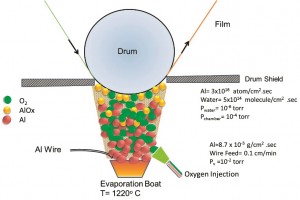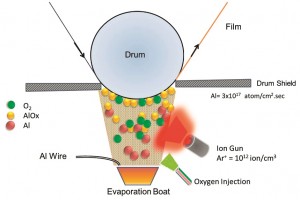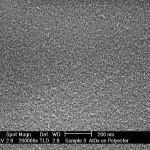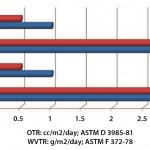Review and evaluation of AlOx clear barrier production processes
Aluminium oxide (AlOx) clear barrier coating has become one of the favoured choices for flexible packaging. Different processes and techniques are used for the production of AlOx on flexible films. The selection of AlOx production process is mainly based on achieved barrier level, low cost, fast production speed and the availability of vacuum web metallisers for industrial production. This paper will review the main AlOx clear barrier production processes available in the market and outline the mechanism of each process.The advantages of using the Plasma Assisted Deposition technique for the production of AlOx with high barrier will be discussed in details. In this technique plasma is used during deposition to enhance the structure of AlOx particularly at the coating/ film interface to increase adhesion, barrier and optical transparency.
Introduction
Most of the transparent flexible barrier coated films available at present are produced by polymeric barrier layers including EVOH and PVDC. The thickness of such layers is in the range of several micrometers to several 10’s of micrometers. However, some of these coatings may contain chemicals like chlorine, which are not considered to be environmentally friendly. Furthermore, polymer resins such as PVA or EVOH have high temperature and humidity dependency that lower gas barrier property. Boiling or retort treatment during converting affects the barrier properties of such laminated film.
The alternative to thick polymeric clear coatings such as PVDC or PVC can be a vacuum clear coating process with a coating thickness several orders of magnitude thinner and in the range of only ~ 10 nanometers achieving the same or better barrier properties than polymeric coatings. Another advantage of vacuum based processes; the coating material for the barrier layers is usually oxide like AlOx, which is non-toxic to the environment.
Although environmental aspects, barrier and optical properties are all important, equally important are cost aspects, process flexibility regarding different base films and coating robustness to survive the converting processes.
AlOx offers other advantages over conventional aluminium metallised film including transparency for easier product identification, microwave transparency, and potential recyclability.
At present, there are vacuum web metallisers available in the market that can be used for conventional aluminium metallisation as well as the production of AlOx.
This paper will outline the physical vacuum deposition processes used in the production of oxygen rich and metal rich AlOx coating onto flexible films such as PET or OPP and will discuss the mechanism of each process particularly the plasma assisted deposition of AlOx..
Vacuum deposition processes used for the production of AlOx
At present, there are two main vacuum deposition processes used for the production of AlOx clear barrier coating. These are:
a. Reactive thermal evaporation of aluminium with oxygen.
b. Plasma assisted deposition.
The selection of a particular process depends on many factors including barrier level required and the financial budget available to acquire a new generation of plasma assisted metalliser or a retrofit onto a standard aluminium metalliser.
a. Reactive thermal evaporation of aluminium with oxygen.
This process is carried out inside a standard vacuum web metalliser. However, during the evaporation of aluminium a controlled injection of oxygen is required to oxidise aluminium and deposit AlOx coating onto the moving web. Aluminium oxide and metal/aluminium oxide can be deposited by aluminium reaction with oxygen. The overall stoichiometry is dependent upon oxygen-to-metal feed ratio during deposition. It is well known that aluminium oxidises very quickly in the presence of oxygen gas or water vapour. For example, in the standard aluminium metallised film there is a low percentage of oxide formation at the interface between the aluminium and the film as well as another oxide layer at the top of the metallised surface. This is due to outgassing of air and moisture from various parts inside the metalliser during metallising. When the metallised film is left in open air after metallisation is complete, the top oxide layer increases in thickness with time due to diffusion of air or moisture. But the growth will slow down and stop eventually. Typically the oxide layer thickness in standard metallised film could be within 2nm-2.5nm almost immediately and 3nm-4.5nm after 1 month to 1 year depending upon exposure conditions. In standard aluminium metallisation process there is always plenty of oxygen in the chamber even at a good base pressure due to outgassing and moisture level in the chamber. For example, at a base pressure of about 1×10-4 mb the arrival rate of oxygen at the film surface could be about 2×1016 atom/cm2.sec , while the arrival rate of aluminium is about 1×1021 atom/sec to deposit 2.5 OD aluminium onto the film. However, this amount of oxygen is not high enough to achieve almost a complete oxidation and clear oxide coating. Therefore, for the production of clear oxygen rich AlOx or metal rich AlOx coatings, a controlled injection of oxygen is directed towards the aluminium vapour stream during metallising causing a reaction between the two elements to produce aluminium oxide (AlOx). The reactive balance between the amounts of oxygen and aluminium produces either oxygen rich or metal rich coating with good barrier. Metal rich coating consist of metallic clusters embedded into an amorphous aluminium oxide matrix. An oxygen rich coating has an amorphous structure. Both of these coatings exhibit gas barrier performance, comparable to that of standard metallised film. Figure 1 shows the schematic of AlOx production process inside a standard aluminium vacuum web metalliser.
The reactive balance between the amount of oxygen and aluminium is very important. In the oxygen rich AlOx coating process, the coating can be clear with an amorphous structure, but if the amount of oxygen is very high the structure can become porous resulting in a poor barrier. If the amount of oxygen is reduced the final AlOx coating will be metal rich with a grey to dark colour. A closed loop feedback control system is usually used to control the optical density of the AlOx coating as a function of the aluminium evaporation rate and oxygen flow rate or pressure.
Figure 2 shows EDX analysis of PET film coated with clear AlOx , which has been deposited at high oxygen pressure. This coating shows a very low amount of aluminium compared to oxygen peak. Such a coating is characterised by a porous structure and poor barrier. EDX analysis results were obtained using the FEI Quanta 250 ESEM microscope interfaced to the EDAX Energy Dispersive X-ray analysis system.
Barrier properties of Polyester film coated with an oxygen rich or metal rich AlOx using thermal reactive evaporation of aluminium with oxygen usually shows OTR and WVTR levels < 5. However, by using a pre and post plasma treatment during the process the barrier level can be reduced to <3. For polypropylene , the barrier property of the AlOx coating depends strongly on many factors including the initial surface condition and the growth mechanism of the AlOx coating. It is possible that the low interaction between hydrocarbon groups in the polypropylene and the aluminium atoms plays an important role in the final barrier level. On the other hand, there is a strong bonding between alumina layer and the carbonyl groups in the polyester resulting in a good barrier.
[caption id="attachment_235" align="alignleft" width="300"]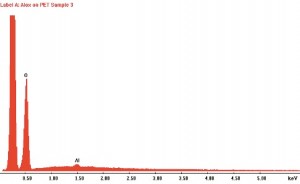 EDAX Analysis of Oxygen rich AIOx clear coating [/caption]
EDAX Analysis of Oxygen rich AIOx clear coating [/caption]
b. Plasma Assisted Deposition of AlOx
In this process a plasma source with a gas such as argon is employed to ionise the oxygen atoms, thus enhancing the chemical reaction with aluminium. Figure 3 shows a schematic diagram of the plasma assisted deposition of AlOx.
3_figure 3Figure 3: Plasma assisted AlOx deposition.
In this process ion gun or a magnetron plasma source is used to bombard oxygen and aluminium molecules with argon ions to increase ionisation and, thus enhance the chemical reaction. This process produces a dense AlOx coating structure with high barrier and optical transparency. In this process the plasma source produces an argon ion density of about 1×1012 ion/cm3. Upon collision with oxygen atoms and aluminium molecules, argon ions cause further ionisation of both species leading to enhanced chemical reaction. Plasma assisted reactive coating of AlOx can produce OTR and WVTR level of 0.5-0.1 in PET. The barrier level of OPP can be improved by using this process but the final level depends strongly on the initial film surface condition and the AlOx/Film interface formation.
Figure 4 shows the surface topography of a PET film coated with AlOx using Plasma assisted process. High resolution surface micrographs were obtained using the Philips XL30 SFEG Scanning Electron Microscope.
Final product
Clear barrier vacuum coated films, particularly those produced by reactive thermal evaporation of aluminium with oxygen, are usually laminated or coated with a top coat for retort or non retort application. The laminated substrate or top coat enhances the moisture and oxygen barrier of the structure. Lamination also protects the coating from mechanical damages during converting processing.
Heat sealable resin top layer is formed by the dry lamination method. A thermoplastic polymer forming a heat sealable resin layer may be used as long as the sealant adhesive level can be sufficiently achieved. Polyethylene resins such as PE, LDPE, LLDPE, PP resin, ethylene –vinyl acetate copolymer and ionomere resin can be used to protect the AlOx coating .
Figure 5 shows the barrier level improvement in the AlOx and Silicon Oxide (SiOx) clear barrier coating prepared by thermal evaporation after lamination. With a plasma assisted deposition of AlOx on PET film the WVTR and OTR values are <0.5 without lamination.
[caption id="attachment_240" align="alignleft" width="150"]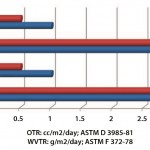 Figure 5: Barrier properties of AlOx and SiOx on PET after lamination.[/caption]
Figure 5: Barrier properties of AlOx and SiOx on PET after lamination.[/caption]
Conclusion
In comparison with wet polymeric atmospheric coating, AlOx vacuum coating requires only a small fraction of the thickness of the equivalent atmospheric coated layer to produce similar functionality. Typically, atmospheric coatings are measured in micrometres (10-6 m) while, vacuum coated AlOx layer is measured in nanometres (10-9m). This reflects a huge environmental and economic advantage for vacuum coating technology.
AlOx is a natural oxide and non- dangerous to the environment or individuals. Recycling and waste management is relatively cheap and simple. In combination with a compostable substrate, it can even be fully bio-degradable.
Metallising of transparent AlOx barrier coating can be accomplished by a standard or specialised vacuum web metallisers. Selecting the most convenient clear barrier AlOx process depends on the application. For a medium barrier, reactive thermal evaporation of aluminium with oxygen is used. For a high barrier requirement plasma assisted deposition process is recommended.
Professor Nadir A. G. Ahmed
He is a Professor of Advanced Materials and Nanotechnology, and founder and managing director of Idvac ltd. His main research interests are in advanced materials using vacuum thin films and nanotechnology to develop new processes for packaging, security holograms, solar window films and smart devices. He worked at Salford and Huddersfield Universities as well as the industrial sector of advanced metallisation and optical coatings.Please note this article originally appeared on http://www.packagingfilms.info


